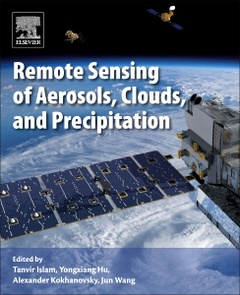Description
Remote Sensing of Aerosols, Clouds, and Precipitation
Coordinators: Islam Tanvir, Hu Yongxiang, Kokhanovsky Alexander A., Wang Jun
Language: English
Subjects for Remote Sensing of Aerosols, Clouds, and Precipitation:
Support: Print on demand
Description
/li>Contents
/li>Biography
/li>Comment
/li>
Remote Sensing of Aerosols, Clouds, and Precipitation compiles recent advances in aerosol, cloud, and precipitation remote sensing from new satellite observations. The book examines a wide range of measurements from microwave (both active and passive), visible, and infrared portions of the spectrum. Contributors are experts conducting state-of-the-art research in atmospheric remote sensing using space, airborne, and ground-based datasets, focusing on supporting earth observation satellite missions for aerosol, cloud, and precipitation studies. A handy reference for scientists working in remote sensing, earth science, electromagnetics, climate physics, and space engineering. Valuable for operational forecasters, meteorologists, geospatial experts, modelers, and policymakers alike.
Section 1 - Remote sensing of aerosols Atmospheric aerosol models Polarimetric aerosol remote sensing Remote sensing of atmospheric aerosol using POLDER Aerosol remote sensing using multispectral imagers Aerosol remote sensing using MODIS Multiangular remote sensing of atmospheric aerosol: MISR experience
Section 2 - Remote sensing of clouds Cloud remote sensing using MODIS Fog detection from a satellite Polarimetric remote sensing of terrestrial clouds Remote sensing of optically thick clouds: theory and applications Cloud top height determination from a satellite
Section 3 - Remote sensing of precipitation Land surface emissivity impact on precipitation remote sensing Passive microwave remote sensing of precipitation Precipitation retrieval using ATMS and SAPHIR Global Precipitation Measurement (GPM) mission Satellite data assimilation for extreme precipitation events
Section 4 - Remote sensing of aerosols-clouds-precipitation interaction Impact of aerosols on clouds and precipitation Aerosol-cloud-precipitation relationships from satellite measurements Cloud microphysics for satellite based precipitation retrieval Changes in precipitation and cloud patterns
Prior to joining NASA/JPL in 2015, he was with the NOAA/NESDIS/STAR, and worked on the development of satellite remote sensing algorithms, with an emphasis on microwave variational inversion techniques (2013-2015). He also held visiting scientist positions at the University of Tokyo, as part of the NASA/JAXA precipitation measurement missions (PMM) algorithm development team, in 2012, and at the University of Calgary, in 2015. He received the Ph.D. degree in remote sensing from the University of Bristol, Bristol, UK, in 2012.
Dr. Islam was the recipient of the Faculty of Engineering Commendation from the University of Bristol (nominated for a University Prize for his outstanding Ph.D. thesis), in 2012, the JAXA visiting fellowship award, in 2012, the CIRA postdoctoral fellowship award, in 2013, the Calgary visiting fellowship award, in 2015, and the Caltech postdoctoral scholar award, in 2015. He has served as a lead guest editor for a special issue on “Microwave Remote Sensing for the Physics and Chemistry of the Earth (Elsevier), and currently serving on the editorial board of Atmospheric Measurement Techniques (EGU) and Scientific Reports (Nature). He has published four books and more than 60 peer-reviewed papers in leading international journals. His primary research interests include microwave remote sensing, radiometer calibration, retrieval algorithms, radiative transfer theory, data assimilation, mesoscale modeling, cloud and precipitation system, and artificial intelligence in geosciences.
Dr. Hu got his PhD degree from University of Alaska, Fairbanks. Since 1995, Dr. Hu has been a research scientist / senior research scientist at NASA Langley Research Center. Dr. Hu began his care
- Presents new approaches in the field, along with further research opportunities, based on the latest satellite data
- Focuses on how remote sensing systems can be designed/developed to solve outstanding problems in earth and atmospheric sciences
- Edited by a dynamic team of editors with a mixture of highly skilled and qualified authors offering world-leading expertise in the field




